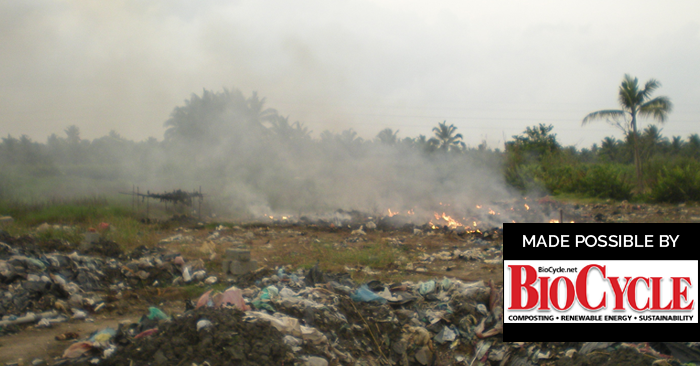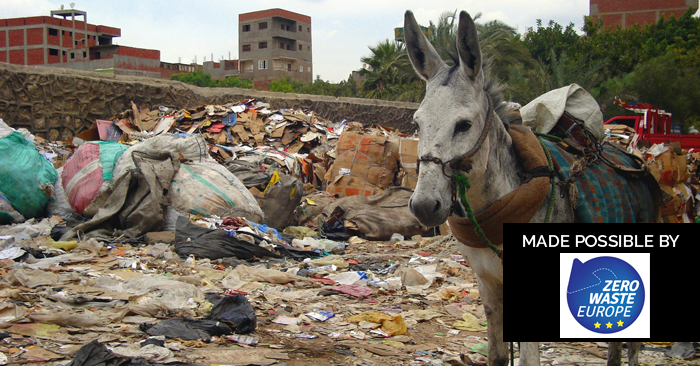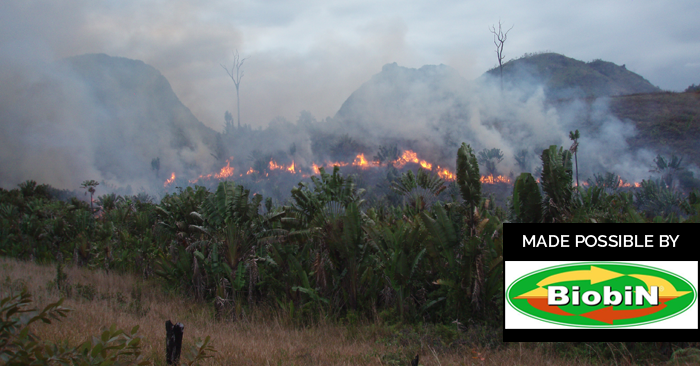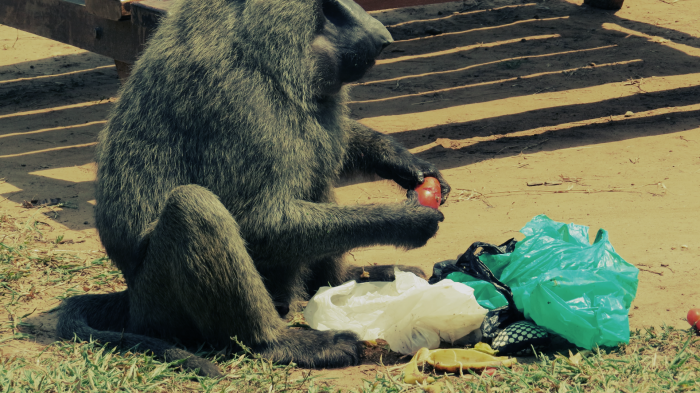Toxic Dump Transformation: A Story from India

This episode corresponds to Lesson 1 of our online course.
In this tenth episode, Master Composter Peter Ash tells us how he helped transform a hospital dump in Kerala, India, from a toxic wasteland into a lush environment – with a dramatic drop in heavy metal quantities in the soil – by using recycling and vermicomposting techniques.
Thank you to the BioCycle for making this episode possible.
BioCycle, the Organics Recycling Authority, is the leading magazine and website on composting, food waste management, anaerobic digestion and renewable energy from organics recycling. Subscribe to BioCycle and get access to every article published over the last 10 years, and sign up for @BioCycle, our free biweekly e-bulletin. For more, visit www.biocycle.net.
TRANSCRIPT:
EM: Just to set the scene a bit, Peter, can you tell us a bit about the AIMS hospital and where it’s situated?
PA: The hospital, AIMS: Amrita Institute of Medical Sciences and Research Centre, they call it AIMS for short. And that, it was really a trip, because this had been a twelve-bed hospital about twenty years ago. And it turned, it grew up, like: everything that…where Amma goes, wherever she has a school or any kind of centre, it just goes from zero to a hundred miles an hour in no time.
So this hospital went from a twelve bed hospital to now a fifteen hundred bed, state of the art hospital and research centre, Med school, dental college, nursing college, school of pharmacology, you know, the whole thing. And with Amma, if you can pay, you pay. And if you can’t, you come and you get served, and you bring your family, and the family stays in the guest house while the patient’s being, you know, treated in the hospital, and everybody eats for super-cheap, and you stay until, you know, everything’s fine, and then you go home.
And so, there’s probably seven to ten thousand students that serve over, probably, twelve hundred patients every day. There’s thousands of employees. And it’s all coastal, tropical wetlands environment. And the hospital, it’s about 7 kilometers inland from the Arabian Sea. The city of Kochi, it’s a huge metropolitan area, you know, India is so densely populated. So there’s Edappally and Ernakulam, all these communities that just all run together – it’s just huge and it’s all interconnected with these waterways.
EM: Okay right, so it’s a densely populated area, and a massive hospital.
PA: Mh-hm.
EM: And often hospitals use incinerators to burn the medical waste – but you were telling me that this one didn’t have an incinerator the first few years, and they were just dumping the medical waste onto the island itself. So, what did the dumping ground look like when you got there – and what did you do?
PA: Basically, when I got to AIMS, the first thing I did was a big waste audit and a site assessment. And they took me around and showed me different properties, and the property I picked was right across this backwater channel connected to the Arabian Sea, to this big island that’s just, not even a meter above sea level. You know, it’s mushy in places. But, where they had been boating the waste, and the food waste – they were just dumping it in the backwaters – but all the other waste, if they couldn’t just easily recycle it, they were taking it over to the island and they were dumping it in pools of water or burning –
EM: And this was from the hospital?
PA: Yes. And for years before they got the incinerator, they had just been taking the hospital waste over to the island and burning it – right on the surface of the island. They took, like, metal rods, stuck them in the ground and made, kind of a rack so they could get some air in it, and they just put the bags…. I’ve got pictures of when I first arrived on the island where they had red hospital waste, you know, medical waste on this rack where they were burning. And the island, right there where they were dumping and burning was so dead that there was no insects, there was no birds, you know, it was just completely dead. And I said, “okay, this is the spot. This is where we’re going to do it. We’re going to have to build a big roof, so we can compost during monsoon season…”.
So, they said, “Well, what do you need?”
“Yeah, well I need this roof…”
“How big?”
“Well, like, by this, by that”
“Okay”
So, they laid it out and they started digging holes to pour concrete to hold up the pillars to hold this roof up. And then all the dumping and stuff that I’d seen, I said “Well” you know, “no more dumping, no more burning. We’re going to sort through this, we’re going to do better recycling. If it’s recyclable and it’s already over here now, we’re going to wash it and send it back to be recycled. If it can’t be recycling, then we’ll bag it up and we’ll send it to the proper incinerator, but no more dumping, no more burning”.
But when they started digging these holes for the footings, they’re like a meter wide, and they’d dig down so they can pour concrete and get…because it’s like the roof…like almost…our initial roof was almost the size of, like, a football field, because we had to build these big windrows of compost. Here we’re talking each day we were going to be composting six to eight metric tons of material a day. So, we’re building these long windrows, you know. We build a pile and then we’d add onto it the next day and add onto it the next day, until we run out of space. So when they start digging these holes, all this stuff starts coming out of the black mud. Syringes, blood vials – with blood still in them – catheters, IV bags, medicine packets…I mean, it was just, it was nasty. It was terrible. And I’m going, “Oh my God”. And they had told me the reason that Amma wanted me to come back was to start composting because they were under a lot of pressure from the State Pollution Control Board. And when I saw what was coming out of the mud, then I understood that, okay, this is not about composting the food waste, this is about the hospital’s impact on the environment.
EM: Hmm, I see…
PA: And Kerala has laws, I mean, they’ve got an environmental policy, they’ve got laws – state laws, federal laws. It’s just that, enforcing laws – they don’t, like, fine you. What they do is, they tell you “Okay, you can’t build anymore”. And with Amma, everything is growing, you know: more students, more patients, more technology, you know. So everything’s got to keep…they’ve got to keep building. And so, we couldn’t hold still. So we had to show them we were getting better.
And we actually, we cleaned up everything we could off the surface, and if it was recyclable, we washed it and bagged it up and sent it back to be recycled. If it couldn’t be recycled, we sent it back to go into the incinerator. What was buried in the mud we couldn’t do anything about because they hole fills up with water, you know. And this was really black, nasty, dangerous toxic mud, you know, with needles and…so we had to be careful.
So what we did was: once we cleaned the surface up, then we just, we took, like, palm fronds and, you know, things that were growing along the water edge. And we laid them out over the surface of the spongy soil, just so we wouldn’t sink into the mud, and we built our compost windrow on top of that, and then we build another one next to it. In two or three days we’d have a whole row of compost. And in the island there was a little channel, where they had been boating with the waste and they’d been dumping on either side. And so, on either side of this little channel, we had a plot where we were making compost. And as soon as we’d turned and spread out the compost on one spot, we’d go right back in there and start composting again. And then we’d be turning and spreading on the other side, and we just kept going back and forth, and we did that for six months waiting for the roof to be finished and the floor to be compacted so that we could get a piece of equipment to turn our windrows by equipment.
EM: Okay.
PA: So, in the six months we’d built about eighteen inches of finished compost on top of the black toxic mud.
EM: Mh-hm…
PA: And before we got too far along, I went and I took a soil sample of the mud – about the upper four to eight inches of mud in this one area. And I had it tested for heavy metals. And I asked them to test for every metal you can test for, and there was only one metal that was not found: antimony. But mercury, lead, selenium, you know, arsenic, it was all in there. And it was way over limits. And we knew that was what it was going to be.
I also took a sample of the river sediment because we’re not the only polluters, you know: all that huge metropolitan area – there’s chemicals, and open sewer lines, and you name it, and the rains are running off, you know. But we did find that, there where I sampled where the dumping and burning had been going on, it was more toxic there than in the river, especially for certain metals.
EM: Mh-hm, okay…
PA: And, but anyway, so then, after six months of composting out in the open, we saw that now there’s all kinds of insects and stuff, you know, in the compost and birds are coming, you know, so it’s, like, coming alive – and then there’s seeds sprouting out of the compost. So we just come out and looked at each other and we go, “Hey, that’s pretty cool. Let’s bring in some clean soil now and mix it, and we’ll start planting stuff, you know, and we’ll restore the habitat here.
EM: That’s incredible. And what else were you doing? You were vermicomposting as well, right?
PA: Yeah. And I’d done some research, you know, like, how people were composting with worms in India, and so we build our own, kind of, open tank system: it’s just basically you build walls about waist-high on a cement floor, you put a roof over it, you put netting between the wall that’s about a meter high or less, up to the rood so it’s shaded and so birds can’t get in. And you have a little drainage on the floor so if there’s any liquid leaching out of the vermicompost pile, then you can capture that because it’s got nutrients in it. And so we started a lot of vermicomposting.
And then when we started planting plants, we used a lot of the fresh vermicompost to plant the plants with. So we knew we were inoculating the soil with earthworms, you know: there’s going to be some babies, there’s going to be some hatching eggs. And I knew that, from research that I’d done, that worms actually extract heavy metals out of the food that they’re eating. So getting earthworms into this new ecosystem that we’re building is going to be a good thing.
EM: Yeah, and we’ll talk a bit about what happened with the soil in a minute. Just before that though, can you give me a little bit more information on the logistics of the whole thing, and equipment you were using? How did you…?
PA: You know, everything gets boated over to the island – everything. You know, all the construction materials, all the cement blocks, the sand, the roofing materials, and then, you know, all of our plants for gardening and you know. And then all the food waste and the woodchips and…and then, we found this manufacturer in India that made this agricultural shredder, and then we bought this shredding machine to shred palm fronds and…. But we needed to shred a lot of wet materials too, like fresh coconut and green coconut palm fronds, and that wet stuff tends to clog up a lot of material. And so we found that this shredder machine – we bought a little one and we tested it, and then we had our own mechanics and fabricators and engineers look at it, and we told them what we needed and so we made some modifications to it. And then we took it back to the manufacturer and we said, “Look: we want to buy the big model, in fact we want to buy a couple of them, but we need these modifications build into it, because we’ve got to run a lot of wet stuff through it, and the way it’s designed right now, it clogs up. So we worked with the manufacturer and they built us, you know, the one that we needed.
But then we also needed some compost turning equipment, but nobody in India really makes composting equipment, you know: commercial scale composting equipment – there’s no compost turners, there’s no big filtering machines for compost. So, you know, I found a YouTube video of a farmer in Northern California that built his own compost windrow turner by taking the rear axle out of a heavy truck and just done a bunch of modifications: he welded this big tube onto the wheel hub, and he connected the differential onto the tractor on the power take off, you know, the tractor, to drive this differential.
Then he had this big tube with these paddles welded on it, so that you could lower it down next to the compost pile and you could drive the tractor beside the pile, and this tube with these paddles on it is now going to turn – and the thing is, this tractor is going forward, but this tube, this big metal pipe with these paddles on it, has got to turn the opposite direction; it’s got to be going, like, in reverse, as opposed…you know, so it can lift up the pile with, you know, these paddles welded to it: lift it up and throw it up into the air to get it aerated. And at the same time, we spiraled them around the tubes, so that it would actually throw the edges of the pile towards the middle, and the middle of the pile to the outside. Because that’s what we want: we want the middle of the pile on the outside, and we want the outside of the pile moved to the inside. So, we bought a tractor, and we built the compost windrow turner to put on it.
EM: That’s brilliant. And going back to the soil now – what was it like after all the work you were doing?
PA: Yeah, so I’ll tell you what, here’s what happened was: last April, I went to the very same site that I took the original sample. And I dug down below the compost and the imported soil, down into the same black mud that I took the original sample from. And so I went and I did the same thing, in the same area, in the same soil layer, and I took that sample in. And it turned out that, like, in the upper eight to ten inches of that same original layer, we reduced three of the metals to non-detectible levels. Two others, we reduced them so that they’re still detectable, but they’re within safe limits for food consumption. There’s still three metals that we’ve reduced by at least fifty percent, but are still too high for human consumption.
EM: That’s still incredible, though, isn’t it?
PA: It is, especially when you consider that so much of the food in India is grown with overdoses of toxic chemical pesticides and fertilisers and stuff, that if that food was tested compared to the plants that are being grown on the island, they probably wouldn’t be much different.
EM: Okay, interesting…
PA: And we did, in just over three years, what we did on that island – reducing the metals the way we did – that’s unheard of! It’s unheard of. You know, and, so we’ve written some papers and I’ve presented this to different conferences…I presented this last fall to the Global Humanitarian Technology Conference in San José, California. We had another presentation at a conference held in India, also late last summer.
EM: Okay cool, so you’ve been busy trying to get the word out about this. And how do you explain to people what happened with the soil – do you know how exactly the results came about?
PA: Yeah, so what we’re finding is, like, there are a lot of different things that are happening, and we don’t know all the answers, you know, that how this could happen so quickly. We know that the earthworms are playing a part; we know that some of the plants are accumulators, or hyper-accumulators or metals. So we can plant certain plants that will pull metals out of the soil. And then, what do you do with the plant, you know? Can you compost it? Can you keylate it? Can you change the form of the metal? And then the earthworms, you know, pulling metals out: what happens when the earthworm fills up with all these metals and then it dies? Well, another earthworm eats it, so it keeps it tied up.
And then there’s some keylation that takes place, and it’s some kind of an ion exchange, especially with carbon molecules, apparently, and where there’s active fungi in the soil. You know, and one of the things we did too was we took a biological testing of the soil. Normally, farmers and gardeners to a chemical soil test, you know, they look for NPK, pH and EC – they look at the nitrogen, the potassium, the phosphorous, you know, that kind of thing. And then they want to know, like, how the chlorides – how salty is the soil. So that kind of a typical chemical test – but that’s just really supporting the chemical companies, because then they want to sell you more nitrogen, or more phosphorous, or something to condition the soil with. But if you just make compost, and you get the organic material, and you get all the microorganisms in the soil, then everything takes care of itself. The soil pH neutralises, and then these metals start to get tied up. They get keylated – they pick up or they lose an ion, and now it’s still lead or mercury, or whatever, but it’s no longer in a toxic form that enters into the food chain.
EM: Yeah, exactly. And it’s amazing to see it actually happening!
PA: Absolutely.
EM: And before we go now – because we don’t have much time – is there anything else you’d like to add, or some advice you’d like to give to people listening in?
PA: Well, you know: whether it’s composting or habitat restoration, or reforestation, or just permaculture design, or even just backyard gardening, you know, the key that I see is that: we just need to look at natural ecosystems – how is nature doing this? You know? What we need to do is mimic nature. Assist nature. As gardeners and farmers, when we see pests or we see weeds, we often ask the wrong questions. We go, “What fertiliser do I need?” or “What pesticide do I need”, you know? And that’s the wrong question. Those are all wrong questions.
We need to look at what’s out of balance in the soil, in the ecosystem. What’s out of balance so that these pests are coming? Why are the pests there, why are the weeds there? These are nature’s cleanup crew. The plant diseases and the insect pests are nature coming in and taking out a plant that can’t live there because something’s missing. And what’s missing is the microbiology. If all the microbiology is in place, then the plant will feed itself and be happy and healthy.
EM: That’s great advice, Peter. But that’s all we have time for now. Thank you very much for coming on the show to speak with us.
PA: My pleasure.
EM: All right, okay thanks.
PA: Thank you.
EM: Bye.
PA: Bye.



